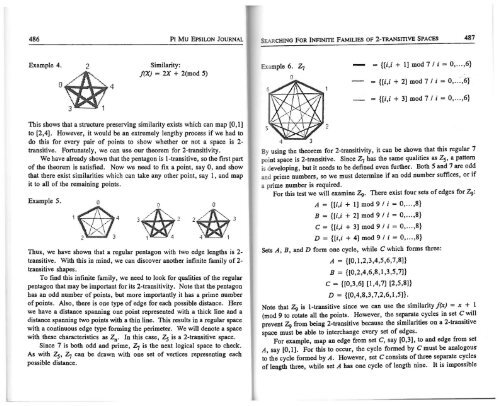Vol. 10 No 6 - Pi Mu Epsilon
Vol. 10 No 6 - Pi Mu Epsilon
Vol. 10 No 6 - Pi Mu Epsilon
- No tags were found...
You also want an ePaper? Increase the reach of your titles
YUMPU automatically turns print PDFs into web optimized ePapers that Google loves.
486 PI MU EPSILON JOURNAL<br />
SEARCHING FOR INFINITE FAMILIES OF 2-TRANSITIVE SPACES 487<br />
Example 4. 2 Similarity:<br />
f(X) = 2X + 2(mod 5)<br />
Example 6. Z,<br />
(I<br />
- = {[i,i + 1] mod 7 I i = 0, ... ,6}<br />
= {[i,i + 2] mod 7 I i = 0, .. :,6}<br />
= {[i,i + 3] mod 7 I i = 0, ... ,6}<br />
This shows that a structure preserving similarity exists which can map [0,1]<br />
to [2,4]. However, it would be an extremely lengthy process if we bad to<br />
do this for every pair of points to show whether or not a space is 2-<br />
transitive. Fortunately, we can use our theorem for 2-transitivity.<br />
We have already shown that the pentagon is !-transitive, so the first part<br />
of the theorem is satisfied. <strong>No</strong>w we need to fix a point, say 0, and show<br />
that there exist similarities which can take any other point, say 1, and map<br />
it to all of the remaining points.<br />
Example 5. 0<br />
0<br />
@<br />
- .-)<br />
3 ~<br />
I<br />
1 4<br />
Thus, we have shown that a regular pentagon with two edge lengths is 2-<br />
transitive. With this in mind, we can discover another infinite family of 2-<br />
transitive shapes.<br />
To find this infinite family, we need to look for qualities of the regular<br />
pentagon that may be important for its 2-transitivity. <strong>No</strong>te that the pentagon<br />
has an odd number of points, but more importantly it has a prime number<br />
of points. Also, there is one type of edge for each possible distance. Here<br />
we have a distance spanning one point represented with a thick line and a<br />
distance spanning two points with a thin line. This results in a regular space<br />
with a continuous edge type forming the perimeter. We will denote a space<br />
with these characteristics as Z 0<br />
• In this case, z 5 is a 2-transitive space.<br />
Since 7 is both odd and prime, Z, is the next logical space to check.<br />
As with z 5 , Z, can be drawn with one set of vertices representing each<br />
possible distance.<br />
4<br />
2<br />
By using the theorem for 2-transitivity, it can be shown that this regular 7<br />
point space is 2-transitive. Since Z, has the same qualities as Zs, a pattern<br />
is developing, but it needs to be defined even further. Both 5 and 7 are odd<br />
and prime numbers, so we must determine if an odd number suffices, or if<br />
a prime number is required.<br />
For this test we will examine ~·<br />
A = {[i,i + 1] mod 9 I i = 0, ... ,8}<br />
B = {[i,i + 2] mod 9 I i = 0, .. . ,8}<br />
C = {[i,i + 3] mod 9 I i = 0 , .. . ,8}<br />
D = {[i,i + 4] mod 9 I i = 0, ... ,8}<br />
There exist four sets of edges for~:<br />
Sets A, B, and D form one cycle, while C which forms three:<br />
A = {[0,1,2,3,4,5,6,7,81}<br />
B = {[0,2,4,6,8,1,3,5,7]}<br />
c = {[0,3,6] [1 ,4,7] [2,5,81}<br />
D = {[0,4,8,3,7,2,6,1,5]}.<br />
<strong>No</strong>te that ~ is !-transitive since we can use the similarity/(~) = x +. 1<br />
(mod 9 to rotate all the points. However, the separate cycles m set C w11l<br />
prevent ~ from being 2-transitive because the similarities on a 2-transitive<br />
space must be able to interchange every set of edges.<br />
For example, map an edge from set C, say [0,3], to and edge from se~<br />
A, say [0,1]. For this to occur, the cycle formed by C must be analogous<br />
to the cycle formed by A. However, set C consists of three separate cycles<br />
of length three, while set A has one cycle of length nine. It is impossible
















